Once again, Thredbo, that little village, high – ok, so it is only 1365m, but in Australia, that is high – in the Australian Alps, has dished up some great festival music.
Cool blues in the January heat (Thredbo Blues Festival 2015) and hot traditional and contemporary jazz in the crisp Autumn air (Thredbo Jazz Festival 2015) make great excuses to get into Kosciuszko National Park. I’ve said it before: (Summer Blues; All that Jazz; Blues in Colour) I love music in the mountains!
The venues: outdoor verandahs at risk from wind and rain; restaurants with crowded tables and clanging cutlery; dark indoor spaces with glaring, streaming backlight from the bright afternoon sun; pubs with laughing conversations behind and bouncing dancers in front; all make for photographic challenges – but that is part of the fun.
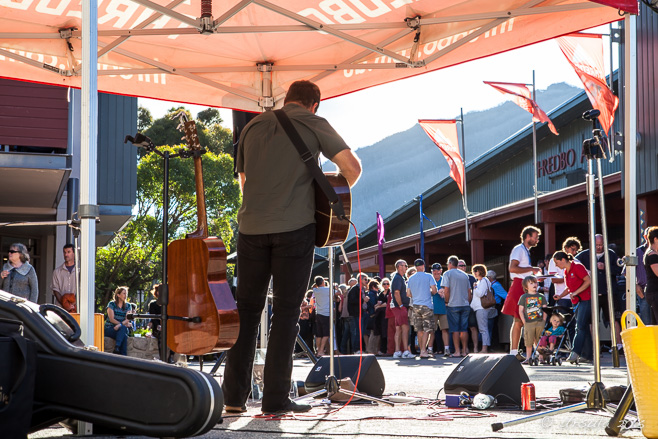 Brody Young
The festivals start with the collection of a wrist band at the office – and a Yalumba wine tasting or three – on the Village Square.  Doggn It Blues Duo
From the Village Square, we move into the closest restaurant for good food, more wine, …  John Cupit on Harp
… and great sounds …  Doggn It
… as local groups play the blues the Aussie way.  Phil and Trudy Edgeley
We always try to take in a lunch performance at Eagles Nest (1937m) at the top of the chairlift; …  Merritts Nature Track
… it gives us such a good excuse to walk back down.  Trigger Plant (Stylidium montanum)
The flora along the trail provide a good excuse for a pause: this track was longer and steeper than I remembered.  Shaun Kirk
Back in the Village, one-man-powerhouse Shaun Kirk is filling the tiny courtyard at Berntis with wonderful, joyful sounds. People are standing and sitting wherever they can grab a space – I was hanging to a railing on a steep staircase to take this shot.  Rory Ellis with Andrew Toner
We were so blown away by Rory Ellis’ music and songs that we booked the dinner show – and bought a CD. I tried to upload a track for you, but the Mac won’t read it: think Jonny Cash meets Burl Ives.  Making Mojitos
The drinks were pretty good, too.  Swamphouse
Meanwhile, in the Schuss Bar, it could be late night in Louisiana, as Swamphouse stomp out their “gutbucket boogie”.  Charlie A’Court
An absolute crowd-pleaser, visiting Canadian Charlie A’Court took up residence in the Lounge Bar.  Matt Burrows
It’s the stuff of fairy tales! Charlie A’Court was at Narooma’s Great Southern Blues Festival in October 2013, and on impulse, handed his guitar to a 16-year-old in the audience. That youngster, Matt Burrows, so impressed Charlie – and the audience – that he earned a spot at the Thredbo Blues (see: Guitar Kid Gets Dream Break) –  Matt Burrows with Charlie A’Court
– and back on stage with Charlie.  Andrea Marr
Singer-songwriter Andrea Marr chats to a fan …  Music: “Andrea Marr Play On/Off”
… as the music stands and the Funky Hitmen wait to introduce her …  Funky Hitmen Saxophone
… with bold, brassy sounds.  Russell Morris
An Australian icon and Australian Recording Industry Association (ARIA) inductee, Russell Morris didn’t disappoint.  Rory Ellis with Andrew Toner
Dinner as the sun went down marked the end of our Blues…  Dixie Street Allstars
… but we were back in May for some Dixie jazz in the Autumn sun.  Piano: Sydney Latin Allstars  Belle Peppers
Making room for the band and their equipment, while fitting in the diners is a tricky balance, but the venues manage. Lunch at the Knickerbocker is always a treat; Liza Ohlback and the Belle Peppers were added seasoning.  Ali Penney
Sun streams over the hill behind her, as Ali Penney sings her heart out.  Keyim Ba
For a complete change of pace, we headed back to the Lounge Bar for an Australian-based West African band that had everyone up dancing.  Sibo Bangoura
Percussionist with joy and attitude, Sibo Bangoura had us all smiling with him …  Richard Adams
… as did Richard Adams of The Nairobi Trio – in a completely different way.  The Nairobi Trio
Why Nairobi? I don’t know – as they perform jazz standards and, to me, have a celtic + gypsy flavour.  Illya Szwec
We are plunged back into darkness for great sounds and excellent food, as we enjoy classic blues & roots music from Illya Szwec and his band, in the Cascades Restaurant. This week, a FaceBook friend of mine posted a reference to a study claiming that, on average, people stop listening to new music at age 33 – to which my friend quipped: “33 1/3”.
I didn’t read the study, so I don’t know if “new music” meant new genres, young musicians, or just new takes on old standards. I don’t know who that study talked to, but I was well over 33 when my children were still at home exposing me to their “new music”. Granted, I didn’t love all of it. But, I listened.
Now, I get annual doses of it at local music festivals.
And, I love it as much as I did when I was 33.
🙂
Keep Smiling!
Pictures: 16-18January2015 and 02May2015
 Sunrise from Deurali
Mount Machhapuchchhre (Machhapuchhre) pokes through the clouds as the sun rises over the Annapurna Range, Nepal. I had something hot and tropical planned for this Week’s Wander – especially after last week’s foray into the cold winds of the southern Andes (Patagonia).
But, since the devastating Himalayan earthquake on April 25th, I cannot get Nepal out of my mind. Clearly, judging from my Facebook feed, I am not alone. In true six- (or fewer-) degrees of separation, everyone I know has some connection with the country.
Nepal was my first experience of “the other”; the truly foreign – my first taste of the developing world. A world where they burn bodies openly on the river in the daytime and burn garbage in the streets at night; a land where, even in 2001, there was almost no phone service outside the cities; a country with unremitting noise and smells, and the worst toilets imaginable.
And I loved it.
From the dusty, noisy chaos that is Kathmandu, through the lowland lakes and jungles, to the magnificent soaring peaks that are the Himalaya(s), I loved it all.
I spent five weeks trekking and travelling in Nepal back in 2001, and I was itching to go back as soon as I left. But then the royal family was murdered, opening the way for an increase in the civil unrest that was already brewing while I was there, and the country became markedly less safe for many years.
When I arrived in February of 2001, descending through the low-lying clouds and the haze of pollution and dust into Kathmandu, the airport was little more than a glorified tin shed. Even with upgrades, it is currently struggling to cope with the flood of increased traffic attempting to help the relief effort. I was carrying a brand-new SLR film camera that I had no idea how to use: being really technically-minded about these things, I had bought a Canon over a Nikon in the same price range because it was lighter. In my defence, when you are carrying packs up and down mountain paths in the Himalaya, weight matters. Looking at the photos now, I can see how much my “photographic eye” has changed over the years, and I realise my cheap scanner is not up to photographic quality.
Still, this post is more about the memories – souvenirs in French – than it is about the photographs themselves.
Please join me on a trip down memory lane. to a beautiful country where the people have always struggled, and are, today, struggling more than ever.
 Street Shave
Kathmandu was my first experience outside the “developed” world. Fortunately for me, it was winter, so it was not too hot – keeping the assault of smell at bay. The rickety bus to the hotel provided a welcome buffer against the culture shock of the rubble, the dust, the skinny dogs and kids, the odd cow, the garbage and the throngs of people with something to sell… Motorcycles, ancient buses and tuk tuks crowded everywhere. Car horns pipped constantly – day and night.
Of course, after years of living and working in Asia, I’m an old hand at all of this, and navigate it easily. But, you always remember your first.  Cremation Ghats
Tourists were not allowed on the ghats themselves, …  Bagmati River
… so we stayed at a respectful distance across the river.  Cremation Ghats ~ Bagmati River
The ghats were relatively quiet, and only a few funeral pyres were burning when I was there in 2001; at the moment, they cannot keep up with the earthquake casualties, and are running out of the wood it takes to consume a body.  Sakyapa Gompa, Bodhnath
Buddhist and Hindu temples rub shoulders in the Kathmandu Valley. I don’t know about this particular temple, but many districts have been completely flattened by the quake. For a photographer’s view on the ground, check out the recent posts by Gavin Gough who is in Nepal at the invitation of an NGO: “Nepal Earthquake”  Colourful Truck
I spent most of the drive from Kathmandu to the starting point of our Annapurna trek with my nose pressed to the window: I’d never before seen sadhus travelling on roadsides and traffic that seems to have no regard for rhyme or rules.
The parlous state of the roads – even before the earthquake and aftershocks tore through them – is making distribution of relief even more difficult.  Trail Head at Naya Phul (Nayapul)
This is where the fun starts! Off the bus we trundled. We walked across the Modi River; through the gauntlet of shops selling scarves (necessary against breathing too much dust), water bottles and trinkets; and into the Annapurna Conservation Area.  Our Sherpa Guides: Dendi, Dipak, Ongchhu and Purna
These were our Sherpas. In addition, our small group of seven trekkers had four porters who carried the overnight bags, and brought us our morning wash-water (no showers) and hot tea (no coffee!), etc. The Australian company (Peregrine) I travelled with ensures that porters are properly paid, not overly burdened, and have decent footwear. In a country as poor as Nepal, these minimal conditions are often not met. Sherpa guides called a strike in 2014 over conditions and compensation after the deadly avalanche on Mount Everest.  Kids Begging
Children hang around trekkers, looking beseeching and adorable. They have got into the habit of begging for sweets and pens. We gave donations to the local schools instead of caving into them.  Girl at the Well
Once we entered the mountains, we had very little running water and no electricity. For me, it was only days at a time; for the locals, this is a way of life. Of course, with the earthquake, access to clean water has become much more difficult – even in the city.  Goat Herder
“Childhood” is a relative construct. In countries like Nepal, children start work at a young age.  Up through Rocky Terraces
One thing Nepal has lots of: rock. No shortage. The country actually exports gravel and crushed stone.  Hiunchuli
Our first glimpse of the heavens: Hiunchuli, a 6641 metre peak in the southern part the Annapurna mountain range rises up in front of us.  Terraced Fields
Below us, the terraced farms drop back down to the river: from what we saw, it was mostly cabbage and potato at these altitudes.  Annapurna Daybreak
Every morning we were woken up to a bowl of reasonably warm water for washing, and a cup of tea. Then, we’d eat breakfast (porridge, two eggs, and either Nepalese bread, toast or chapattis) surrounded by snow-covered peaks.  Gurung Woman
The Gurung or Tamu people are one of the many ethnic groups in this region. The famous Gurkha soldiers within the British Army are recruited from these strong, proud people.  “A little Bit Up”
Every day our guide would tell us the next day would involve “a little bit up, a little bit down.” We decided that “A little bit up” was Nepalese for “Bring an ice-pick”. Those hills seemed to go up forever!  Rhododendrons
The famous rhododendron trees of Nepal flower from late February through April.  Machhapuchchhre
Also spelled “Machhapuchhre”, or “Fish Tail” in English, Machhapuchchhre rises up from the forests and into the clouds.  Cornbread for Lunch
“Rustic” is a word that comes to mind; I was not used to people squatting to perform daily tasks, and the concept of food preparation on the the floor of the kitchen was completely foreign to me.  Tadapani (2700 m)
Crude buildings cling precariously to cliffs – always in sight of those magnificent mountain peaks. One of the things that struck me, however, was the noise: as soon as the sun cracked over the horizon, people would be chattering as they went about their work, and the dogs would set off barking as the cocks crowed.  Ghorepani (2874m)
Poon Hill (3210 m) marked the high point of our trek. When we learned it was all back down hill from this point, one of our group broke into a rendition of “The Hills are Alive”. We descended shale steps into Ghore (horse) Pani (water), where traders have long watered their ponies. I remember it as the place I was able to book a short, crackly overseas phone call, at $US200, to touch base with family after several days off the grid.  Sorting Rice – Banthanti (2250m)
Every small task is time consuming. Still, people have the time to smile and chat. I sent this young woman back a copy of the photos I took of her.  Loaded Porter
In many places, the only way to get goods in or out is to carry them. We even saw porters carrying lengths of timber for building.  Ulleri (2070m)
We got used to “basic” accommodation pretty quickly: mud huts, wooden structures perched on the sides of cliffs, tin roofs held down with stones. The “lodges” we stayed in didn’t quite conform to any building code I’m aware of: two foam mattresses on wooden frames in a tiny cubbyhole with drafts that blew out the candles – no electricity, remember. We learned to keep a torch handy for the cold walk to the outhouse in the night. There was no such thing as soundproofing: “Goodnight, John-boy” became a running joke; snores and “Oh yuch, who was that?!” could be heard from the rooms four doors down. At some lodges we could even see each other through the cracks in the walls.  Laundry – Tirkedunga (1525m)
Laundry and dishes are all done manually at the town taps; shampoos and showers are also conducted (modestly) in the same place.  Purna and Friend
While the scenery is magnificent, …  Young Man, Birethanti 1065m
… it’s the people that make a trip.  Modi Khola
A long part of the walk back to Naya Phun is along the beautiful Modi Khola …  Naya Phul Terraces
… to the rice terraces in the river valley. Nepal has always been a a poor country: as a backpacker haven, it hasn’t managed to put the same kind of price-tag on its priceless mountains as its near-neighbour Bhutan, and doesn’t have the resources or infrastructure to manage the current disaster.

My husband and I have had a long relationship with the Himalayan Foundation and supported a child in the Kathmandu Valley through World Vision for many years until they re-focussed elsewhere. I know some of the good people at UNICEF; any of these organisations, or the Red Cross, Oxfam, or other reputable aide groups would be happy to accept any help you can give them.
As would the beautiful, proud people of Nepal.
Let’s help where we can.
Pictures scanned from print photos taken February2001.
Posted in Every Day Life,Nepal,Portraits,TravelTags: architecture,blog,buddhist,Himalaya,hindu,National Park,nature,people,Photo Blog,portrait,portraits,religion,travel,Travel Blog,Ursula Wall,walk
 Monte Fitz Roy under an Autumn Sky
Los Glaciares National Park, Patagonia (30March2006). Buenos dios, fellow travellers!
It is Autumn in the Southern Hemisphere.
I love the colours that mark the changing of the seasons. My corner of Australia never shows much dramatic change, however, and this year we have been battered by winds and rains which have washed away any colours we might have had.
So, to find those magnificent Autumn reds and yellows, I’ve had to turn to the archives, and dig out some old images from Patagonia: that beautiful, sere and windswept landscape in the foothills of the Argentinian Andes.
 Patagonia
Driving through Patagonia: the expansive plateau of semiarid scrub in southwestern Argentina (29March2006).  Guanaco Baby
Wild Guanacos (Lama guanicoe) are the parent species of the domesticated llama. It is always a risk going back to old photos: it was nine years ago that we were in Patagonia, and I was shooting .jpegs on a small digital camera… Still, hopefully the scenery (and a few tweaks in Lightroom) will make up for photographic short-comings.
We had flown from Buenos Aires to el Calafate – via Ushuaia in Tierra del Fuego, which had come as a bit of a surprise as it is not exactly on the way – and then spent more than four hours in an over-heated bus, bouncing over bumps and twisting around bends, before reaching the gravel roads of el Chaltén.
Being in el Chaltén is like being in the early American West: dusty roads and prefab houses, in a forbidding, dry landscape surrounded by magnificent mountains. We kept expecting tumbleweed to roll down the main (only?) street. The town was built in 1985 to help secure the disputed mountainous border with Chile, but continues to exist because of tourism: it is within the Los Glaciares National Park, on the banks of the Río de las Vueltas, and at the base of Cerro Torre and Cerro Fitz Roy mountains.
We spent four days around el Chaltén, galloping over several of the walks in the area, in the wake of our guide Wanda, a delightful Patagonian woman of French-Italian descent, who understood everything except the meaning of “slowly”.
 Río De Las Vueltas
Late afternoon on the De Las Vueltas River; Chile is not far – just through those mountains (29March2006).  ¡Vamos!
Our guide Wanda sets a cracking pace up the hills.  El Chaltén Waterfall
Our first walk is just a “short” one to get the travel kinks out.  Sendero al Fitz Roy
The next morning we set off climbing up above the Río De Las Vueltas valley towards Fitz Roy (30March2006).  Ñire
Some of the wonderful colours we start to see around us are thanks to the Antarctic Beech (Nothofagus antarctica), a deciduous tree or shrub native to Patagonia.  Autumn Colours
There are several nothofagus (southern beech) species native to South America: ñires, guindos, and lengas amongst them.  Beech Bush Colours
Beech shrubs cover the lowlands; beech trees grow higher up (30March2006).  Sendero a Laguna de los Tres
The trip notes called this 18km hike to Laguna de los Tres ‘relatively easy’; …  Fitz Roy
…it certainly gave us magnificent views of Fitz Roy, otherwise known as Cerro el Chalten. Chaltén is an old tehuelche (Indian) word meaning smoking mountain. We were blessed with blue skies, but the peaks are usually covered by clouds, and the Tehuelche tribes thought the mountain was a volcano.  Rocky Creek Crossing
Creek crossing on the way to Poincenot base camp.  Ground Cover
These calafate berries are not quite ripe – they are like blueberries when they are ready.  Laguna de Los Tres
The peaks of Fitz Roy and the blue, glacial waters of Laguna de Los Tres …  Wanda’s Lunch
… make a great spot for a well-earned lunch break.  Lago Capri
We skirt Capri Lake on our walk back …  Hut
… past an emergency shelter …  El Chaltén
… and down to el Chaltén, which looks like a frontier town on the plateau (30March2006).  Cerro Torre
Our walk towards Cerro Torre the next day was slightly shorter and easier, but it was so windy at the top at Laguna Torre that we literally couldn’t breathe or speak, let alone take pictures (31March2006).  Pony
We shared the trail with tough mountain ponies.  Pony Train
A pony train carries out the last campsite of the season as winter looms (31March2006).  Sunrise over Cerro Torre
Early the next morning we caught the sunrise over the surrounding mountains.  Lomada de Pliege
The day may have started out clear, but it was bleak, blustery, and very wet at the top of the Lomada de Pliege. A faint rainbow showed through the mist (01April2006).  Lake Argentina
In the wet weather, it was a slog up the 500m rise to Loma del Pliegue Tumbado. A brief break in the rain afforded the ‘excellent panoramic views of the area’ promised in the trip-notes.  Loma del Pliegue Tumbado
We headed back down over the rocky landscape …  Our Guide
… and followed the intrepid Wanda through the grasses and back to the cover of the beech trees. Heading back to base, we were blasted by the gale-force winds for which Patagonia is rightly famous. It was surreal trying to push forward through the pelting rain and howling wind, carrying with it the biting cold from the nearby glaciers and stinging sand from the unsealed streets of town. I kept thinking I’d be blown straight back to the mountain, like a tumbleweed in a bad western movie. When I finally reached the hotel, I was so sodden that the receptionist took one look at me and whisked me away from the entry. She was steering me towards the laundry drying-room to strip off – but with my Spanish and her English, at the time I had no idea where she was taking me!
Exhausted over our last dinner, I never-the-less felt exhilarated, and somewhat sorry for those who had stayed safely at home, missing an unrepeatable experience.

After all, who ever had an adventure playing it safe?
Till next time ~
Pictures: 30March2006-01April2006
Posted in Argentina,Landscapes,Nature,TravelTags: argentina,landscape,National Park,nature,Patagonia,Photo Blog,travel,Travel Blog,Ursula Wall,walk
 Orange Headdress and Dimples
The Pa’O (Black Karen) people are the second largest ethnic group in the Shan State of Myanmar. Inle Lake, in the Shan Hills in central Myanmar, is a unique environment.
I’ve written before about it’s floating villages (Life on the Water) and about it’s distinctive leg-rowing fishermen (Iconic Images). Most of the lake’s 70,000 residents live in villages and towns on the shore line, where everyday life includes bustling local markets and quiet Buddhist worship.
 Bridge over the Waterways
The villages around the lake are accessible only by boat. Indein (In Dein) Village is a short trip up the Indein River – one of the many rivers in and out of Inle Lake. My time on Inle Lake included a visit to Indein Village on the western bank, where the local Pa’O (Black Karen) people were conducting their market exchanges in the brilliant, slanting sunlight.
 Pa’O Hill People
Called Taungthu, which means ‘hill people’ in Burmese, the Pa’O are the seventh largest ethnic minority in Myanmar.  Pa’O Man
Forced to wear dark indigo-dyed clothing after the defeat of the Mon King Makuta of Thaton by King Anawratha in 1057, today the Pa’O are known for their brightly-coloured turbans.  Pa’O Woman in Red
Considered part of the larger Tibetan-Himalayan ethnic family, the Pa’O have been in Myanmar since around 1000 B.C.  Pa’O Market Woman
Called “Black Karen” by the British colonialists because of the dark blue or black clothing originally enforced on them by King Anawratha, the Pa’O share elements of language and culture with other Karen groups.  A Face in the Crowd
The morning market is a busy place.  Heads Together
Lively exchanges are happening everywhere.  Woman Selling Greens  Young Women  Young Hill Tribe Women
The young women in the markets are happy to engage with us and to be photographed.  Young Women  Cooking Rice Cakes  Monks with Begging Bowls
Wooden carved figurines are among the items for sale.  Buddha-Head and Trinkets
Jewellery made from silver and semi-precious stones is also popular.  Marionettes  Into the Temple
Unlike many Karen groups, the Pa’O have been predominantly Buddhist for centuries.  Old Stones
The area around Indein – sometimes known as Shan Bagan – is dotted with pagodas or stupas, begun in the 12th century and added to by Shan princes up until the 18th century.  Artistic Ability
The corridors leading into the main temple house crafts-people and artisans.  Pa’O Girls
It’s not hard to get the young women to take a break from their gift stalls…  Pa’O Woman
… and pose for us, flashing their dimpled smiles.  Dog at the Chedi Ruins
Many of the stupas or chedi are overgrown and falling into ruins, …  Chedi Ruins
… which is probably not a bad thing, …  Overgrown Stupas
… as there has been criticism of the quality of the restoration work being done.  Fallen Statue  Chedi in the Flowers  Children at the Chedi  Peacock Flowers (Caesalpinia Pulcherrima)  Crumbling Chedi  Boats on the Indein
Too soon, it is time to leave the village – by boat, of course. Some visitor-reports to TripAdvisor rue the state of the stupas around Indein Village. I think these people may have forgotten that they are not in a theme park: these monuments are built by, and for, the local people as an expression of their faith.
 We are merely visitors. We are merely visitors.
I am always amazed and pleased by the warmth of the smiling welcome that greets us.
Until next time ~
Pictures: 21September2012
Posted in Architecture,Every Day Life,Myanmar,PortraitsTags: architecture,blog,buddhism,children,environmental portrait,environmental portraits,market,Myanmar,people,Photo Blog,sculpture,travel,Travel Blog,Ursula Wall,worship
 Tying a Turban
Rajasthan is known for it’s colourful turbans: the uniform turbans worn by the attendants in Mehrangarh Fort in Jodhpur are a case in point. Rajasthan is known for it’s colourful fabrics: especially the “crowning” turbans of the men which hark back to the Rajput land-owners and rulers. Traditionally, the size and style of the turban denoted status and rank, and different colours were worn for different purposes, like weddings and celebrations, or during different seasons.
Holy men in white or saffron turbans are still a common sight across India, but in Rajasthan every village, region, or workplace has its own fashion or style.
The male workers at Mehrangarh Fort in Jodhpur wear a turban as part of their uniform. During one of my visits there, with photographer Karl Grobl and local guide DV, I was treated to a demonstration of their turban-tying skill. In the days of royal courts, young women were employed to tie men’s turbans for them, but today, most men take pride in tying their own – taking care that none of the 25 meters of fabric touches the ground.
 Mehrangarh Fort (2008)
High (120 metres – 400 feet) over the blue city of Jodhpur, the ancient fortress of Mihirgarh (“Sun Fort” in Sanskrit) protected a number of palaces and now houses historical museum galleries.  Into the Shadows
At the entry to Mehrangarh Fort, Indian women wear a mix of modern and traditional clothing (Kameez – shirts or blouses – worn over Shalwar or leggings, with Dupatta multi-purpose scarves) in colourful fabrics. Of course, Saris are also common.  Traditional Musicians
However they tie them, the men working around Mehrangarh Fort wear the same turbans in yellow, with green and red accents.  Playing the Pipes
The Achkan, a knee length jacket, over trousers, completes their uniform.  Guard at the Gate  Man with a Hookah  Arches on the Corridor
The hallways and corridors of Mehrangarh Fort are beautifully balanced and delicately carved.  Tying a Turban
The brightly coloured turban cloths are 25 meters long, …  Tying a Turban
… so getting one neatly wrapped takes time and help.  Stating a Turban  Finishing a Turban  Turbaned
The finished product gets a pat-down…  Men in Turbans  Tying a Turban
One of the other men demonstrates a different style, …  Setting the Turban
… getting it well settled on his head …
 Intricate Turban
… before flashing us a big smile.  Turban in a Window
The delicate filagree work around the windows is quite beautiful.  Moti Mahal (2008)
The Moti Mahal, or Pearl Palace, inside the Mehrangarh Fort, is a stunning testament to the glorious Rathore dynasty.  Elephant’s Howdah (2008)
One of the museum galleries contains some fine examples of the elaborate two-compartment wooden seats that were attached to the backs of elephants as chairs.  Turban – 2008
The colours and patterns of the fabric in the “uniform turban”…  Turban – 2013
… have changed over the years.  Cloth Merchant
In a gift shop, a salesman in an elaborately waxed moustache and beard shows off a different style of turban.  The Beard
Our hookah-smoking friend shows up at the exit to show off his beard to full advantage.  Mother and Daughter
A mother and child share a drink before leaving the fort.  On the Way Out
A family pauses on the walkway leading between the fort and Jodhpur below. 
It’s a glimpse into a world with a completely different sense of sartorial style.
Namaste!
Pictures: 15April2008 and 06November2013
Posted in India,Portraits,TravelTags: architecture,blog,environmental portrait,environmental portraits,museum,portrait,portraits,travel,Travel Blog,Ursula Wall
« Older posts
Newer posts »
|
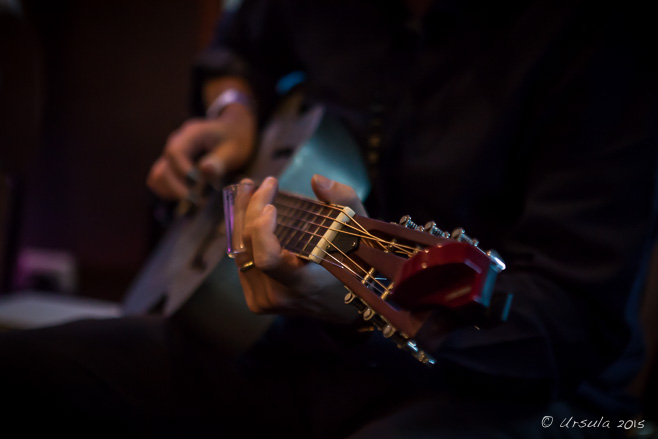
































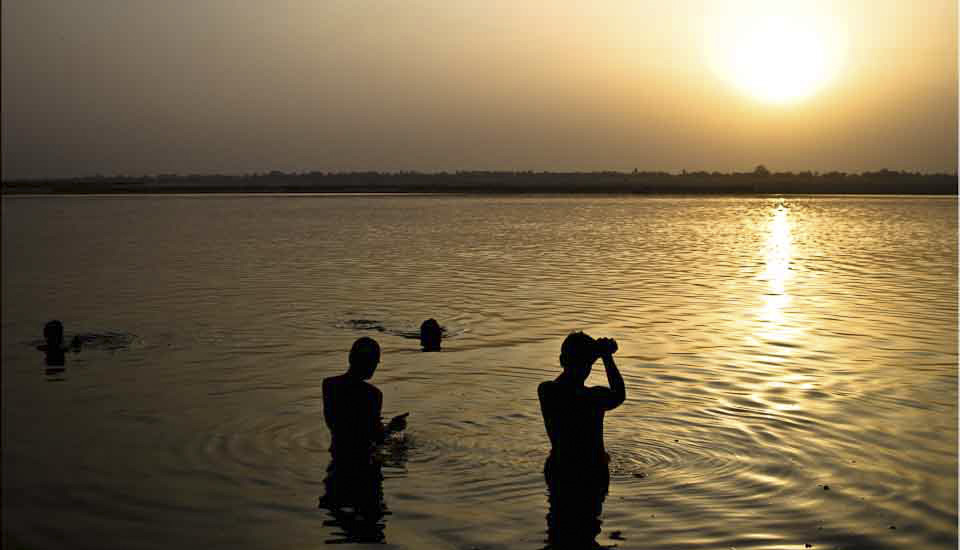


























































































.jpg)


































































.png)
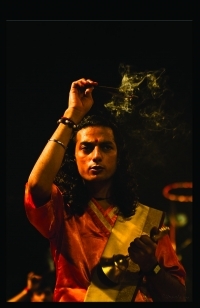
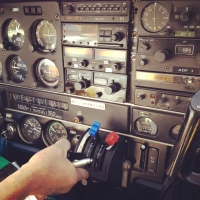
[…] favourites, Rory Ellis, was performing. We enjoyed him at Thredbo Bluesfest several years ago (see: Cool Blues, Hot Jazz) and were thrilled when we heard he was back – and especially excited when he replayed one of […]